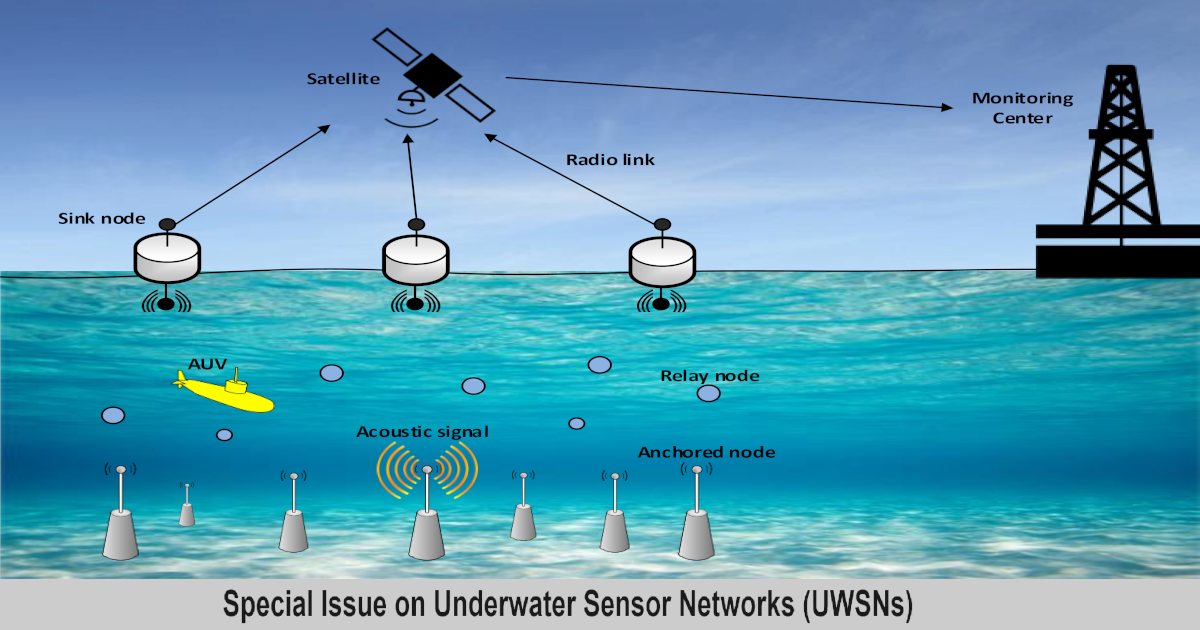Underwater Sensor Networks (UWSNs)
A special issue of Journal of Marine Science and Engineering (ISSN 2077-1312). This special issue belongs to the section "Ocean Engineering".
Deadline for manuscript submissions: closed (20 January 2022) | Viewed by 22942

Special Issue Editor
Interests: Routing protocols in Underwater Sensor Networks (UWSNs); MAC protocols in UWSNs; localisation in UWSNs; Autonomous Underwater Vehicles (AUVs); operational research in marine engineering sciences and applications
Special Issue Information
Dear Colleagues,
This Special Issue focuses on all aspects related to Underwater Sensor Networks (UWSNs). Works related to different layers of UWSNs are welcome, such as the physical, routing, or MAC layer. Innovative aspects related to UWSNs applications will also be considered. Contributors are advised to submit papers that fit in one or more of the subjects indicated below. However, papers that are not directly related to these areas shall also be considered in cases of particular interest to this Special Issue.
- Underwater sensor networks communication
- UWSNs routing protocols
- UWSNs MAC protocols
- Mobile data gathering using autonomous underwater vehicle (AUV)
- Underwater sensor localization and tracking
- Underwater wireless networks theories, protocol designs and architecture
- Internet of things for UWSNs
- Underwater surveillance and monitoring
- Energy harvesting and management in UWSNs
- Study cases, real deployments of UWSNs
- Security issues for UWSNs
- Operational research in UWSNs
- Reliability and scalability in UWSNs
- Underwater sensor network architectures
- Wired and wireless protocols for UWSNs
Dr. Seyed Mohammad Ghoreyshi
Guest Editor
Manuscript Submission Information
Manuscripts should be submitted online at www.mdpi.com by registering and logging in to this website. Once you are registered, click here to go to the submission form. Manuscripts can be submitted until the deadline. All submissions that pass pre-check are peer-reviewed. Accepted papers will be published continuously in the journal (as soon as accepted) and will be listed together on the special issue website. Research articles, review articles as well as short communications are invited. For planned papers, a title and short abstract (about 100 words) can be sent to the Editorial Office for announcement on this website.
Submitted manuscripts should not have been published previously, nor be under consideration for publication elsewhere (except conference proceedings papers). All manuscripts are thoroughly refereed through a single-blind peer-review process. A guide for authors and other relevant information for submission of manuscripts is available on the Instructions for Authors page. Journal of Marine Science and Engineering is an international peer-reviewed open access monthly journal published by MDPI.
Please visit the Instructions for Authors page before submitting a manuscript. The Article Processing Charge (APC) for publication in this open access journal is 2600 CHF (Swiss Francs). Submitted papers should be well formatted and use good English. Authors may use MDPI's English editing service prior to publication or during author revisions.
Keywords
- Underwater Sensor Networks (UWSNs)
- Routing
- Autonomous Underwater Vehicle (AUV)
- Medium Access Control (MAC)
- Localization systems
- Internet of Things (IoT)
- Energy harvesting
- Reliability
Benefits of Publishing in a Special Issue
- Ease of navigation: Grouping papers by topic helps scholars navigate broad scope journals more efficiently.
- Greater discoverability: Special Issues support the reach and impact of scientific research. Articles in Special Issues are more discoverable and cited more frequently.
- Expansion of research network: Special Issues facilitate connections among authors, fostering scientific collaborations.
- External promotion: Articles in Special Issues are often promoted through the journal's social media, increasing their visibility.
- e-Book format: Special Issues with more than 10 articles can be published as dedicated e-books, ensuring wide and rapid dissemination.
Further information on MDPI's Special Issue policies can be found here.





